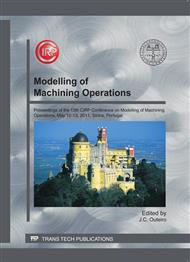p.3
p.12
p.20
p.30
p.37
p.46
p.56
p.66
A Lagrangian FEM Model to Produce Saw-Toothed Macro-Chip and to Study the Depth of Cut Influence on its Formation in Orthogonal Cutting of Ti6Al4V
Abstract:
The foundations of micro-milling are similar to macro-milling but the phenomena it involves are not a simple scaling-down of macro-cutting. The importance of the minimum chip thickness is one of the significant differences between the two processes. The lagrangian FEM model presented in this paper aims to study the depth of cut influence on chip formation of Ti6Al4V in orthogonal cutting. It is firstly used to compare the modelled saw-toothed macro-chip morphology and cutting forces to experimental cutting results from literature. Then a minimum chip thickness prediction is performed by decreasing the depth of cut. Finally this study is the opportunity to highlight the specific features of micro-cutting reported in literature, such as the effective negative rake angle of the tool or the size effect. The model presented brings therefore a numerical contribution to the comprehension of these phenomena.
Info:
Periodical:
Pages:
3-11
Citation:
Online since:
April 2011
Price:
Сopyright:
© 2011 Trans Tech Publications Ltd. All Rights Reserved
Share:
Citation:


